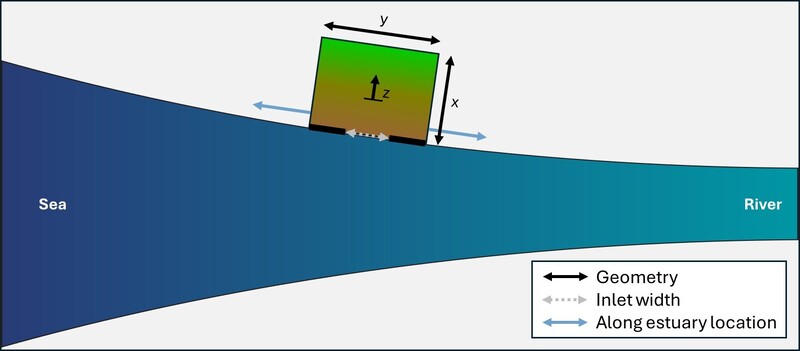J. Bootsma1*, B.W. Borsje1, R.W.A. Siemes1,2, D. van der Wal1,3, S.J.M.H. Hulscher1
1 University of Twente, the Netherlands; 2HKV lijn in water, the Netherlands; 3Royal Netherlands Institute for Sea Research (NIOZ), the Netherlands
* Corresponding author: jesse.bootsma@utwente.nl
Introduction
Restoring intertidal area through managed realignment is gaining attention to enhance biodiversity and flood resilience in estuaries. However, these restoration projects can also influence estuarine salt dynamics. Previous research has shown that the impact of intertidal area on salt intrusion varies depending on estuary classification (stratified vs. well-mixed) (Hendrickx & Pearson, 2024; Siemes, 2024). Furthermore, a case study in the Scheldt estuary demonstrated that managed realignment sites can either increase or decrease salt intrusion length depending on their location (Riepen, 2024). In such a well-mixed estuary, intertidal restoration near the estuary mouth tends to reduce the salt intrusion length, whereas sites further upstream may have the opposite effect. Building on these insights, this study aims to assess how restoration of intertidal areas influences salt intrusion across different estuarine types, with a specific focus on geometry and location of the restored intertidal area.
Objective and Methods
We utilize a 3D hydrodynamic model with an idealized estuary geometry using Delft3D-FM (Hendrickx & Pearson, 2024). By varying river discharge and tidal range, we were able to study a range of estuary types (salt wedge, partially mixed and well-mixed). This study focuses on short estuaries where the salt intrusion length is comparable to the tidal excursion length, making tidal dispersion the dominant salt transport mechanism. In these systems, restoring intertidal areas is expected to have a significant impact on salt intrusion dynamics due to the higher ratio of intertidal area to total estuary area. Additionally, we investigate the effect of open versus constrained inlets of restoration projects, analyzing their influence on water level-flow velocity phase differences causing tidal trapping, which is known to significantly affect salt intrusion in short estuaries.
Results
Initial model results show that substantial intertidal area is required to affect salt dynamics at the estuary scale. By focusing on short estuaries, a higher ratio of connected intertidal area to estuary area is achieved, increasing the potential for significant changes in salt intrusion. Further analysis will aid in our understanding how different realignment configurations modify estuarine salt dynamics across varying estuary types.

Schematic overview of the scenarios. For a typical funnel-shaped estuary, a managed realignment site is connected in which the geometry, inlet width and along estuary location is varied
References
Hendrickx, G. G., & Pearson, S. G. (2024). On the Effects of Intertidal Area on Estuarine Salt Intrusion. Journal of Geophysical Research: Oceans, 129(9), 1–12. https://doi.org/10.1029/2023JC020750
Riepen, M. (2024). Location of Managed Realignment Sites in Scheldt Estuary has Opposing Effect on Salt Intrusion. MSc Thesis University of Twente.
Siemes, R. W. A. (2024). Modelling the Effect of Human Interventions and Climate Change Impacts on the Sediment Balance and Salt Intrusion in Engineered Estuaries. PhD thesis University of Twente. https://doi.org/10.3990/1.9789036562591


